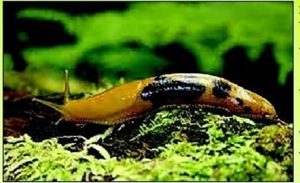


Most of us have planted our garden beds and vegetable plots by now, as freezing temps are unusual in the middle of May. The wind however has been cold recently and our delicate tomatoes and annuals are surely shivering and will just stop growing until it gets warmer again. Now the real challenge begins! There are predators in our midst: deer browsing our roses, rabbits nibbling any fresh new growing leaves and then there are……slugs!
The largest slug is the banana slug, (Ariel max columbianus) the only native slug and second largest species in the world (20 cm in length). It comes in varying colours of light green and green with ripe banana-like brown spots. This slug is a good slug, it is seldom found on our garden crops. It enjoys mostly dead vegetation.
The black slug, (Arion ater), comes in shades of brown. It has ridges or furrows on back and often an orangey edge on its “foot”. This mollusk will roll into a ball when gently poked and will then wobble slowly from side to side to confuse its predator. It dines voraciously on fungi, lichens, carrion, feces, and vegetation.
The leopard or grey slug (Limax Maximus), my all-time favourite, is classy and elegant looking (if there even is such a thing in slugs). This pretty slug mostly resides in forest margins, cellars, sheds, greenhouses, and cemeteries etc. It prefers munching on fungi and dead matter. This slug moves 4 times faster than the banana slug (6 inches a minute!) and it stalks and eats other smaller slugs and is mostly nocturnal.
They all have one thing in common, SLIME! Slugs make 3 kinds of slime, one to slide over bumpy surfaces, one to protect from drying out and another toxic slime to numb their predators’ tongues. Some researchers think that snail mucus shows promise at hydrating human skin, since it contains hyaluronic acid, which improves the appearance of fine lines helping wounds and skin scratches heal faster.
Slugs are:
- hermaphrodites, they possess both male and female organs. Simply any other slug in their path is a candidate for love😜! Up to 200 eggs are laid under wood or rock piles several times a year. Mating occurs while both are hanging upside down from a tree branch (Watch “Life in the undergrowth” by David Attenborough).
- Slugs are invertebrates, they have no backbone, but a protective partial cover called a “mantle”, it hides their reproductive organs, lungs, and anus.
- They have only one “foot”, a muscle which helps them move. And a “skirt” or foot fringe which surrounds the foot.
- They have no teeth, but an organ called a radula, a minutely toothed ribbon like structure used for scraping food before swallowing.
- In the mantle a small hole on left, it opens and closes for breathing and is a called a pneumastome.
- Two retractable optical tentacles are used for sight and smell and two lower sensory tentacles for taste and touch.
- Gastropod in Greek means “stomach-foot”.
- Their live span is from 1 to 5 years.
- One slug can produce up to 90,000 (!) babies in its lifetime.
- The only sure way to remove slugs from your yard is …….…….to get some ducks!
